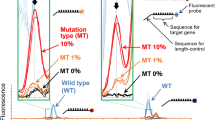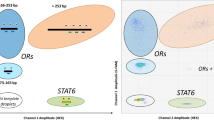Abstract
The efficacy of targeted therapy is associated with multi-gene mutation status. Carrying out effective multi-genotyping analysis in combination has been a challenge in clinical settings. We therefore developed a droplet-based capillary electrophoresis (CE) system coupled with PCR-restriction fragment length polymorphism (PCR-RFLP) technology to detect multi-gene mutations from a small volume of samples. A 16 × 16 200-nL droplet array for sample encapsulation was constructed on a glass chip. The electrophoresis system consisted of a tapered vertical capillary filled with polyvinylpyrrolidone, a laser-induced fluorescence detector, and a high voltage power supply. Notably, a droplet-based electrokinetic sample introduction method and a “∩” shape capillary were developed to facilitate consecutive droplet sampling using a home-made automatic control module. The DL2000 DNA marker was consecutively separated, achieving high migration time and plate number reproducibility. The system was further applied to detect PCR-RFLP products. For colorectal cancer (CRC) cell lines, KRAS, BRAF, and PIK3CA were genotyped with a sensitivity of 0.25%. For CRC patient specimens, 30 samples were consecutively and automatically multi-genotyped without inter-sample contamination, with a lowest mutation frequency of 0.37%. For the first time, we developed a droplet-based CE system for consecutive DNA analysis with low sample consumption. This automated CE system could be further developed to integrate the full process of gene mutation detection, serving as a more effective platform for individualised therapy.





Similar content being viewed by others
Change history
23 September 2020
The authors would like to call the reader���s attention to the fact that unfortunately the name of Jianzhang Pan was missing as co-author of this contribution.
References
Suzawa K, Offin M, Lu D, Kurzatkowski C, Vojnic M, Smith RS, et al. Activation of KRAS mediates resistance to targeted therapy in MET exon 14-mutant non-small cell lung cancer. Clin Cancer Res. 2019;25:1248–60.
Piawah S, Venook AP. Targeted therapy for colorectal cancer metastases. A review of current methods of molecularly targeted therapy and the use of tumor biomarkers in the treatment of metastatic colorectal cancer. Cancer. 2019;125:4139–47.
Sorich MJ, Wiese MD, Rowland A, Kichenadasse G, McKinnon RA, Karapetis CS. Extended RAS mutations and anti-EGFR monoclonal antibody survival benefit in metastatic colorectal cancer: a meta-analysis of randomized, controlled trials. Ann Oncol. 2015;26:13–21.
Santos C, Azuara D, Garcia-Carbonero R, Alfonso PG, Carrato A, Elez ME, et al. Optimization of RAS/BRAF mutational analysis confirms improvement in patient selection for clinical benefit to anti-EGFR treatment in metastatic colorectal cancer. Mol Cancer Ther. 2017;16:1999–2007.
Aleksakhina SN, Kashyap A, Imyanitov EN. Mechanisms of acquired tumor drug resistance. Biochim Biophys Acta Rev Cancer. 2019;1872:188310.
Ramos P, Bentires-Alj M. Mechanism-based cancer therapy: resistance to therapy, therapy for resistance. Oncogene. 2015;34:3617–26.
Rotow JK, Gui P, Wu W, Raymond VM, Lanman RB, Kaye FJ, et al. Co-occurring alterations in the RAS-MAPK pathway limit response to MET inhibitor treatment in MET exon 14 skipping mutation-positive lung cancer. Clin Cancer Res. 2020;26:439–49.
Zhao B, Wang L, Qiu H, Zhang M, Sun L, Peng P, et al. Mechanisms of resistance to anti-EGFR therapy in colorectal cancer. Oncotarget. 2017;8:3980–4000.
Yaeger R, Kotani D, Mondaca S, Parikh AR, Bando H, Van Seventer EE, et al. Response to anti-EGFR therapy in patients with BRAF non-V600-mutant metastatic colorectal cancer. Clin Cancer Res. 2019;25:7089–97.
Tural D, Batur S, Erdamar S, Akar E, Kepil N, Mandel NM, et al. Analysis of PTEN, BRAF and PI3K status for determination of benefit from cetuximab therapy in metastatic colorectal cancer patients refractory to chemotherapy with wild-type KRAS. Tumour Biol. 2014;35:1041–9.
Kwon Y, Kim M, Jung HS, Kim Y, Jeoung D. Targeting autophagy for overcoming resistance to anti-EGFR treatments. Cancers (Basel). 2019;11:1374.
French D, Smith A, Powers MP, Wu AHB. KRAS mutation detection in colorectal cancer by a commercially available gene chip array compares well with Sanger sequencing. Clin Chim Acta. 2011;412:1578–81.
Del Vecchio F, Mastroiaco V, Di Marco A, Compagnoni C, Capece D, Zazzeroni F, et al. Next-generation sequencing: recent applications to the analysis of colorectal cancer. J Transl Med. 2017;15:1–19.
Spencer DH, Zhang B, Pfeifer J. Single nucleotide variant detection using next generation sequencing. 1st ed: Elsevier; 2015. p. 109–27.
Kakavas VK, Konstantinos KV, Plageras P, Panagiotis P, Vlachos TA, Antonios VT, et al. PCR-SSCP: a method for the molecular analysis of genetic diseases. Mol Biotechnol. 2008;38:155–63.
Liu W, Li B, Chu H, Zhang Z, Luo L, Ma W, et al. Rapid detection of mutations in erm (41) and rrl associated with clarithromycin resistance in Mycobacterium abscessus complex by denaturing gradient gel electrophoresis. J Microbiol Methods. 2017;143:87–93.
Li WM, Hu TT, Zhou LL, Feng YM, Wang YY, Fang J. Highly sensitive detection of the PIK3CA H1047R mutation in colorectal cancer using a novel PCR-RFLP method. BMC Cancer. 2016;16:1–11.
Lang AH, Drexel H, Geller-Rhomberg S, Stark N, Winder T, Geiger K, et al. Optimized allele-specific real-time PCR assays for the detection of common mutations in KRAS and BRAF. J Mol Diagn. 2011;13:23–8.
Huang Y, Wei L, Sun AM, Li B, Sun CJ, Liang WB, et al. Application of multiplex methylated-specific PCR with capillary electrophoresis to explore prognostic value of TSGs hypermethylation for hepatocellular carcinoma. J Clin Lab Anal. 2018;32:e22430.
Ruan J, Li M, Liu YP, Li YQ, Li YX. Rapid and sensitive detection of Cronobacter spp. (previously Enterobacter sakazakii) in food by duplex PCR combined with capillary electrophoresis-laser-induced fluorescence detector. J Chromatogr B Analyt Technol Biomed Life Sci. 2013;921–2:15–20.
Harstad RK, Johnson AC, Weisenberger MM, Bowser MT. Capillary electrophoresis. Anal Chem. 2016;88:299–319.
Wang R, Xie H, Xu YB, Jia ZP, Meng XD, Zhang JH, et al. Study on detection of mutation DNA fragment in gastric cancer by restriction endonuclease fingerprinting with capillary electrophoresis. Biomed Chromatogr. 2012;26:393–9.
Galievsky VA, Stasheuski AS, Krylov SN. “Getting the best sensitivity from on-capillary fluorescence detection in capillary electrophoresis” - a tutorial. Anal Chim Acta. 2016;935:58–81.
Price AK, Paegel BM. Discovery in droplets. Anal Chem. 2016;88:339–53.
Basova EY, Foret F. Droplet microfluidics in (bio)chemical analysis. Analyst. 2015;140:22–38.
Niu X, Pereira F, Edel JB, de Mello AJ. Droplet-interfaced microchip and capillary electrophoretic separations. Anal Chem. 2013;85:8654–60.
Zhu Y, Fang Q. Analytical detection techniques for droplet microfluidics-a review. Anal Chim Acta. 2013;787:24–35.
Li Q, Zhu Y, Zhang NQ, Fang Q. Automatic combination of microfluidic nanoliter-scale droplet array with high-speed capillary electrophoresis. Sci Rep. 2016;6:26654.
Tan X, Wang H, Luo G, Ren S, Li W, Cui J, et al. Clinical significance of a point mutation in DNA polymerase beta (POLB) gene in gastric cancer. Int J Biol Sci. 2015;11:144–55.
Fang XX, Li HY, Fang P, Pan JZ, Fang Q. A handheld laser-induced fluorescence detector for multiple applications. Talanta. 2010;150:135–41.
Zhang T, Fang Q, Du WB, Fu JL. Microfluidic picoliter-scale translational spontaneous sample introduction for high-speed capillary electrophoresis. Anal Chem. 2009;81:3693–8.
Ahmed D, Eide PW, Eilertsen IA, Danielsen SA, Eknæs M, Hektoen M, et al. Epigenetic and genetic features of 24 colon cancer cell lines. Oncogenesis. 2013;2:e71.
Rachiglio AM, Lambiase M, Fenizia F, Roma C, Cardone C, Iannaccone A, et al. Genomic profiling of KRAS/NRAS/BRAF/PIK3CA wild-type metastatic colorectal cancer patients reveals novel mutations in genes potentially associated with resistance to anti-EGFR agents. Cancers (Basel). 2019;11:859.
Feinberg AP, Koldobskiy MA, Göndör A. Epigenetic modulators, modifiers and mediators in cancer aetiology and progression. Nat Rev Genet. 2016;17:284–99.
Zhang YX, Zhu Y, Yao B, Fang Q. Nanolitre droplet array for real time reverse transcription polymerase chain reaction. Lab Chip. 2011;11:1545–9.
Hatch AC, Ray T, Lintecum K, Youngbull C. Continuous flow real-time PCR device using multi-channel fluorescence excitation and detection. Lab Chip. 2014;14:562–8.
Chen F, Rang Y, Weng Y, Lin L, Zeng H, Nakajim H, et al. Drop-by-drop chemical reaction and sample introduction for capillary electrophoresis. Analyst. 2015;140:3953–9.
Cheng YQ, Yao B, Zhang HD, Fang J, Fang Q. An automated capillary electrophoresis system for high-speed separation of DNA fragments based on a short capillary. Electrophoresis. 2010;31:3184–91.
Fang XX, Fang P, Pan JZ, Fang Q. A compact short-capillary based high-speed capillary electrophoresis bioanalyzer. Electrophoresis. 2016;37:2376–83.
Opekar F, Tůma P. Direct sample injection from a syringe needle into a separation capillary. Anal Chim Acta. 2018;1042:133–40.
Shao J, Li S, Zhang W, Fan LY, Cao CX, Sun R, et al. Controlling of band width, resolution and sample loading by injection system in a simple preparative free-flow electrophoresis with gratis gravity. J Chromatogr A. 2010;1217:2182–6.
Llovet P, Sastre J, Ortega JS, Bando I, Ferrer M, García-Alfonso P, et al. Prognostic value of BRAF, PI3K, PTEN, EGFR copy number, amphiregulin and epiregulin status in patients with KRAS codon 12 wild-type metastatic colorectal cancer receiving first-line chemotherapy with anti-EGFR therapy. Mol Diagn Ther. 2015;19:397–408.
Pietrantonio F, Vernieri C, Siravegna G, Mennitto A, Berenato R, Perrone F, et al. Heterogeneity of acquired resistance to anti-EGFR monoclonal antibodies in patients with metastatic colorectal cancer. Clin Cancer Res. 2017;23:2414–22.
Garcia-Albeniz X, Pericay C, Alonso-Espinaco V, Alonso V, Escudero P, Fernández-Martos C, et al. Serum matrilysin correlates with poor survival independently of KRAS and BRAF status in refractory advanced colorectal cancer patients treated with irinotecan plus cetuximab. Tumour Biol. 2011;32:417–24.
Lurkin I, Stoehr R, Hurst CD, van Tilborg AAG, Knowles MA, Hartmann A, et al. Two multiplex assays that simultaneously identify 22 possible mutation sites in the KRAS, BRAF, NRAS and PIK3CA genes. PLoS One. 2010;5:e8802.
Funding
This research work was financially supported by the National Natural Science Foundation of China (Grant number 81672920 and 21375149).
Author information
Authors and Affiliations
Corresponding authors
Ethics declarations
The ethics committee approved the use of these samples for the purpose of academic research, and all patients who donated samples provided written informed consent.
Conflict of interest
The authors declare that they have no conflict of interest.
Additional information
Publisher’s note
Springer Nature remains neutral with regard to jurisdictional claims in published maps and institutional affiliations.
Electronic supplementary material
ESM 1
(DOCX 3889 kb)
Rights and permissions
About this article
Cite this article
Feng, Y., Hu, T., Fang, P. et al. Consecutive and automatic detection of multi-gene mutations from colorectal cancer samples by coupling droplet array-based capillary electrophoresis and PCR-RFLP. Anal Bioanal Chem 412, 3037–3049 (2020). https://doi.org/10.1007/s00216-020-02567-y
Received:
Revised:
Accepted:
Published:
Issue Date:
DOI: https://doi.org/10.1007/s00216-020-02567-y




